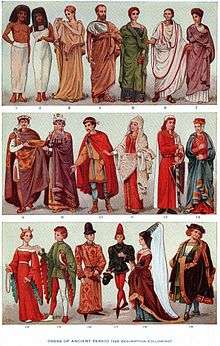Cravat
The cravat (/krəˈvæt/) is a neckband, the forerunner of the modern tailored necktie and bow tie, originating from a style worn by members of the 17th century military unit known as the Croats.[1]
.jpg)
From the end of the sixteenth century, the term band applied to any long-strip neckcloth that was not a ruff. The ruff, a starched, pleated white linen strip, originated earlier in the sixteenth century as a neckcloth (readily changeable, to minimize the soiling of a doublet), as a bib, or as a napkin. A band could be either a plain, attached shirt collar or a detachable "falling band" that draped over the doublet collar. It is possible that initially, cravats were worn to hide soil on shirts.[2] Alternatively, it was thought to serve as psychological protection of the neck during battle from attack by a spear.
History
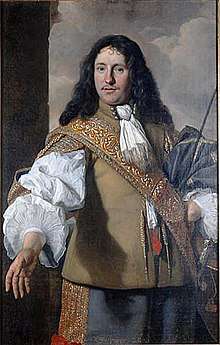
According to the 1828 encyclopedic The art of tying the cravat: demonstrated in sixteen lessons, the Romans were the first to wear knotted kerchiefs around their neck, but the modern version of the cravat (French: la cravate) originated in the 1660s. During the reign of Louis XIV of France, Croatian mercenaries were enlisted in 1660 wearing a necktie called a tour de cou.[3] The traditional Croat military kit aroused Parisian curiosity about the unusual, picturesque scarves distinctively knotted at the Croats' necks:
"In 1660 a regiment of Croats arrived in France — a part of their singular costume excited the greatest admiration, and was immediately and generally imitated; this was a tour de cou , made (for the private soldiers) of common lace, and of muslin or silk for the officers ; the ends were arranged en rosette , or ornamented with a button or tuft, which hung gracefully on the breast. This new arrangement, which confined the throat but very slightly, was at first termed a Croat, since corrupted to Cravat. The Cravats of the officers and people of rank were extremely fine, and the ends were embroidered or trimmed with broad lace ; those for the lower classes were subsequently made of cloth or cotton, or at the best of black taffeta, plaited: which was tied round the neck by two small strings."[3]
Prominent early champions of the style were:
 William III of England, here aged 10 in 1660
William III of England, here aged 10 in 1660- John II Casimir Vasa, c. 1660
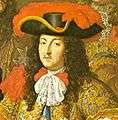 Louis XIV of France in 1667
Louis XIV of France in 1667
Often the Dubrovnik poet Ivan Gundulić is credited with the invention of the cravat, due to a portrait hanging in the Rector's Palace, Dubrovnik. The scholar depicted in the painting looks very much like the frontispiece to his Osman published in 1844. However, considering the hairstyle, this portrait is more probably a later portrait of his namesake Dživo (Ivan) Šiškov Gundulić, also a Dubrovnik poet. In their honor, Croatia celebrates Cravat Day on October 18.[4]
_dielaivanagundu00gundgoog_0008.jpg) Frontispiece for Osman, 1844
Frontispiece for Osman, 1844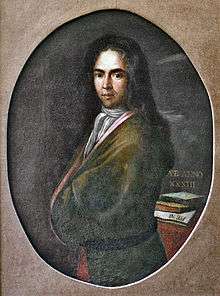 Ivan Gundulić, but more probably his younger relation Dživo (Ivan) Šiškov Gundulić (1678 - 1721)
Ivan Gundulić, but more probably his younger relation Dživo (Ivan) Šiškov Gundulić (1678 - 1721)
On returning to England from exile in 1660, Charles II imported with him the latest new word in fashion: "A cravatte is another kind of adornment for the neck being nothing else but a long towel put about the Collar, and so tyed before with a Bow Knott; this is the original of all such Wearings; but now by the Art and Inventions of the seamsters, there is so many new ways of making them, that it would be a task to name, much more to describe them".[5]
During the wars of Louis XIV of 1689–1697, except for court, the flowing cravat was replaced with the more current, and equally military, "Steinkirk", named after the Battle of Steenkerque in 1692. The Steinkirk was a long, narrow, plain or lightly-trimmed neckcloth worn with military dress, wrapped once about the neck in a loose knot, with the lace of fringed ends twisted together and tucked out of the way into a button-hole, either of the coat or the waistcoat. The steinkirk was popular with men and women until the 1720s.
The maccaronis reintroduced the flowing cravat in the 1770s, and the manner of a man's knotting became indicative of his taste and style, to the extent that after the Battle of Waterloo (1815) the cravat began to be referred to as a "tie".
Steinkirk
A Steinkirk was a type of cravat designed to be worn in deliberate disarray. The fashion apparently began after troops at the Battle of Steenkerque in 1692 had no time to tie their cravats properly before going into action. Colley Cibber's play The Careless Husband (1704) had a famous Steinkirk Scene.
Gallery
- A Regency-style neckcloth tied in a bow on a Grafton collar
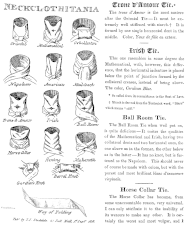 An image from the 1818 Neckclothitania satirizing different cravat knots
An image from the 1818 Neckclothitania satirizing different cravat knots Robert Stewart, Viscount Castlereagh, wearing a cravat
Robert Stewart, Viscount Castlereagh, wearing a cravat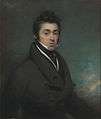 An unknown man wearing a cravat in the early nineteenth century
An unknown man wearing a cravat in the early nineteenth century Colonel Isaac Barre wearing a cravat in the mid-eighteenth century
Colonel Isaac Barre wearing a cravat in the mid-eighteenth century Thomas Tooke wearing a cravat in the late eighteenth century
Thomas Tooke wearing a cravat in the late eighteenth century
See also
References
- Frucht 2004, p. 457.
- Coffignon, A. (1888). Paris vivant. Les coulisses de la mode p.104. La librairie illustrée, Paris
- The art of tying the cravat: demonstrated in sixteen lessons, by H. Le Blanc, 1828
- Heather Horn (October 18, 2012). "The Tie Is a Very Big Deal in Croatia". The Atlantic Cities. Atlantic Media Company. Retrieved 18 October 2012.
- Randle Holme, Academy of Armory and Blazon, 1688.
Sources
- Frucht, Richard C. (2004). Eastern Europe: an introduction to the people, lands, and culture. Vol. 2. ABC-CLIO. ISBN 978-1-57607-800-6.CS1 maint: ref=harv (link)
External links
| Wikimedia Commons has media related to Cravats. |

- The Art of Tying the Cravat (1828) by H. Le Blanc, Esq. (reprinted as ISBN 978-1-145-53416-2)
